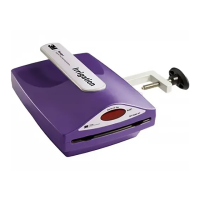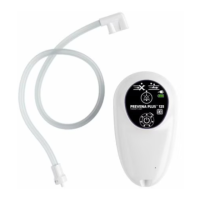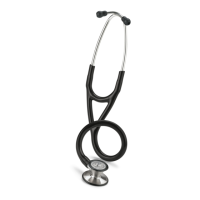14 3M™ Bair Hugger Model 675 Warming Unit – Service Manual
Recommended separation distances between portable and mobile RF communications equipment and the model675
The model 675is intended for use in an electromagnetic environment in which radiated RF disturbances are controlled. The customer or the user of the model 675can help
prevent electromagnetic interference by maintaining a minimum distance between portable and mobile RF communications equipment (transmitters) and the model 675as
recommended below, according to the maximum output power of the communicationsequipment.
Rated maximum output
power of transmitter
W
Separation distance according to frequency of transmitter(m)
150kHz to 80MHz
d =1.2
80MHz to800MHz
d =1.2
800MHz to 2,5GHz
d =2.3
0,01 0.12 0.12 0.23
0,1 0.38 0.38 0.73
1 1.2 1.2 2.3
10 3.8 3.8 7.3
100 12 12 23
For transmitters rated at a maximum output power not listed above, the recommended separation distance d in meters (m) can be estimated using the equation applicable to
the frequency of the transmitter, where P is the maximum output power rating of the transmitter in watts (W) according to the transmittermanufacturer.
Notes
At 80MHz and 800MHz, the separation distance for the higher frequency rangeapplies.
These guidelines may not apply in all situations. Electromagnetic propagation is affected by absorption and reflection from structures, objects andpeople.
MEDICAL — GENERAL MEDICAL EQUIPMENT AS TO ELECTRICAL
SHOCK, FIRE AND MECHANICAL HAZARDS ONLY IN
ACCORDANCE WITH ANSI/AAMI ES60601-1(2005) + AMD 1(2012)
and IEC 80601-2-35; CAN/CSA-C22.2No. 60601-1(2014) and CAN/
CSA-C22.2No. 80601-2-35; ControlNo.4HZ8
Classified under IEC 60601-1Guidelines (and other national versions of the
Guidelines) as: Class Iequipment; Type BF applied part (warming blanket/gown is the
appliedpart); Protection against harmful ingress of water:IPX1; Continuousoperation;
Not suitable for use in the presence of flammable anesthetic mixtures with air or with
oxygen or nitrousoxide.
Frequently Asked Questions (FAQ) onFiltration
What filter is used in the 3M™ BairHugger™ Model675warmingunit?
The Model675uses the same filter media as has for many years been used in prior BairHugger 700-series models. That filter media is classified on an industry-standard scale
as MERV 14at 44CFM (cubic feet per minute) under ASHRAE Standard 52.2-2012: Method of Testing General Air Ventilation Air-Cleaning Devices for Removal Efficiency by
ParticleSize.
1,2
What is a MERVrating?
The Minimum Efficiency Reporting Value, or MERV, is a measurement scale to rate the efficiency of an air filter as a function of particle size based on the ASHRAE
Standard52.2-2012.
1,2
What is the MERV rating recommended for operatingrooms?
ASHRAE Standard 170-2013, Ventilation of Health Care Facilities, provides standards and guidance on the design requirements for ventilation systems utilized in health care
facilities.
3
The standard recommends that operating rooms utilize a filter that is equivalent to MERV 14.
3
This MERV rating is specific to the ventilation system in the hospital’s
operatingroom.
What is the MERV rating recommended for patient warming devices in the operatingroom?
There is no filtration standard for patient warming devices utilized within the operating room. The ASHRAE Standard is a standard used to assess filter efficiency in health care
ventilationsystems.
Is a HEPA filternecessary?
No. We are not aware of any evidence or claim demonstrating that a HEPA filter improves patientsafety.
What is the ASHRAE 52.2-2012standard?
The American Society of Heating, Refrigerating and Air-Conditioning Engineers (ASHRAE) is a global organization focused on research, education and standards for heating,
ventilation, air conditioning and refrigeration. The ASHRAE standard 52.2-2012
1,2
provides test methods for air intake filters to ensure standardization in classification and
efficiency. For more information on ASHRAE, please visit www.ashrae.org.
References:
1. ANSI/ASHRAE Standard 52.2-2012: Method of Testing General Air Ventilation Air-Cleaning Devices for Removal Efficiency by Particle Size. The American Society of Heating,
Refrigerating and Air-Conditioning Engineers, Inc. © 2012ASHRAE. ISSN 1041-2336. Available at http://www.ashrae.org. Accessed on6/7/2016.
2. ANSI/ASHRAE Addenda a, b, and d to ANSI/ASHRAE Standard 52.2-2012. Method of Testing General Air Ventilation Air-Cleaning Devices for Removal Efficiency by Particle
Size. The American Society of Heating, Refrigerating and Air-Conditioning Engineers, Inc. © 2015ASHRAE. ISSN 1041-2336. Available at http://www.ashrae.org. Accessed
on6/7/2016.
3. ANSI/ASHRAE/ASHE Standard 170-2013: Ventilation of Health Care Facilities. The American Society of Heating, Refrigerating and Air-Conditioning Engineers, Inc. ASHRAE.
ISSN 1041-2336. Available at http://www.ashrae.org. Accessed on6/7/2016.
MaintenanceChecklist
□ Filterinspection
1. Remove and inspect thefilter.
2. Return filter or replace asnecessary.
Note: Replace every 12months or 500hours ofuse.
□ Test the alarmfunction
□ Calibrate the operatingtemperature
□ Test the over temperature detectionsystem

